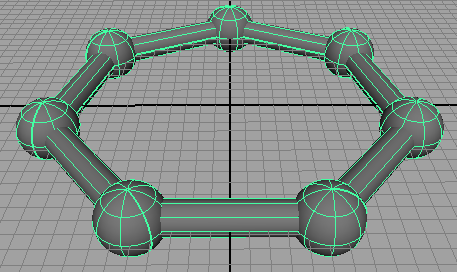Introduction
The mel script in listing 1 produces a ring-like structure built from a repetition of spheres and cylinders - figure 1. This tutorial demonstrates how repetitive modeling can be accomplished using instancing and smart transforms.

Figure 1
Basic Code
Listing 1 provides the code for a procedure that can model a ring consisting
of cylinders and spheres. Given the number of radius of the ring ($R) and the
number of sides ($nsides) the procedure calculates the angle between the cylinders
and their lengths.
Listing 1 (ring.mel)
global proc string ring(int $nsides, float $R)
{
// Give the number of sides and the radius of the "ring"
// calculate its proportions
float $theta = 360.0/$nsides;
float $rads = deg_to_rad($theta/2);
float $A = $R * cos($rads);
float $B = $R * sin($rads);
float $ratio = (2 * $B)/0.5; // cylinder height ratio
// The "ring consists of repeated cylinders and spheres
string $c[] = `cylinder -p 0 0 $A -r .5 -ax 1 0 0 -hr $ratio`;
string $s[] = `sphere -p $B 0 $A -ax 0 1 0`;
select $s[0] $c[0];
// Use either duplication or instancing
//string $d[] = `duplicate -rr`;
string $d[] = `instance`;
rotate -r 0 $theta 0;
// Begin making a array (ie. list) of the items that will
// form the "ring" group
string $names[] = { $s[0], $c[0] };
appendStringArray($names, $d, size($d));
int $n = 2;
for($i = 2; $i < $nsides; $i++)
{
// Use either duplication or instancing
//$d[] = `duplicate -rr -st`;
$d = `instance -st`;
appendStringArray($names, $d, size($d));
}
// Handy for printing the contents of the group
//for($i = 0; $i < size($names); $i++)
// print($names[$i] + "\n");
return `group $names`;
}
|
Calculating the Sides
The calculation of the angle and the length of each cylinder proceeds as follows.

Figures 2 & 3
For the purpose of explaining how the angle and length of each cylinder in the
"ring" is calculated assume the perimeter of the circle in figure 2 is to be
divided into three segments. The angle theta can be found by
dividing 360 degrees by the number of sides. Since sides A and
B form a right-angled triangle, with the radius of the circle
($R) as the hypotenuse, their lengths can be found using trigonometry.
Irrespective of the size of a right-angled triangle, dividing side A by
the hypotenuse ($R) yields a ratio that is constant for the
included angle (theta/2) ie. the sine of the angle.
A/$R = sin(theta/2);
Since theta is known, side A can be calculated as,
A = $R * sin(theta/2);
Because the trigonometry procedures in mel measure angles in radians, not degrees,
the angle, theta/2, is converted to radians prior to being used by sin() and
cos().

